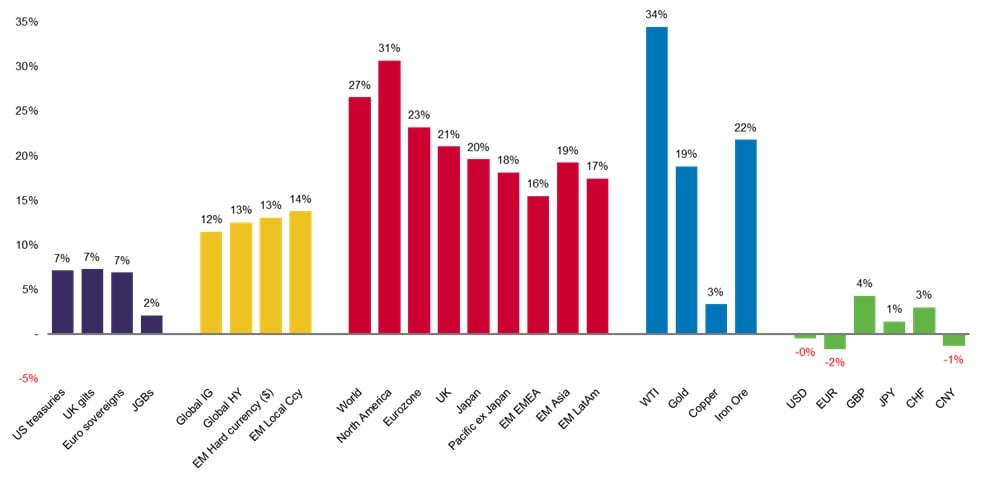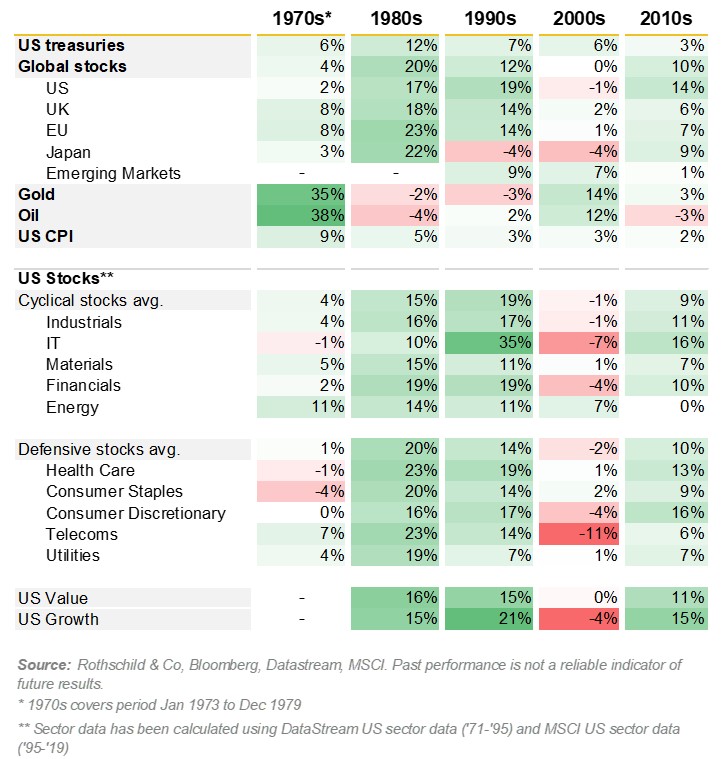Wealth Management: Strategy blog – 2019 – a fine vintage? | The twenty teens – long-term highlights

Strategy team - Victor Balfour (Wealth Management)
We wanted to take stock of 2019, an unusually strong year for markets, and reflect on the decade that has just concluded. It was the best year for US stock markets since 2013, returning +31.5% (the second-best return in the past two decades).
At the start of the year expectations were downbeat in the face of a rather uncompelling market backdrop: geopolitical bluster, slowing economic growth and the promise of negative earnings growth. Yet, now we find ourselves facing a possible détente in the ongoing tariff impasse, growth stabilising and earnings beating expectations.
Clearly base effects played a part too (lest we forget the 2018's worst December since 1931), as did renewed monetary support as US interest rates reversed course. Meanwhile, though equity valuations may have re-rated, they remain undemanding relative to long-term trends. The forward multiple of 18x seems inexpensive relative to the long-term year average of 16x (vs 15x at the end of 2018).
Equities delivered double-digit returns in all major regions and sectors, while bonds also performed strongly against that backdrop of lower rates and few inflationary pressures - at one stage the stock of negative yielding debt globally rose to $18tn, before falling back to $11tn by year-end, as yields shifted higher. Credit outperformed government bonds, especially high yield credit or “junk” bonds, where spreads narrowed right into the year-end, particularly at the lowliest rated segments.
We also witnessed a strong year for oil (new OPEC+ agreement to limit output), Gold (although less so towards year-end as risk appetite improved), and also for various hard and soft commodities. Not shown in the chart below, Palladium was a prominent outlier (+54%), touching an all-time high as supply fears mounted. And outside the realm of what we consider to be investable assets, Bitcoin (+90%) staged a sharp comeback before falling back somewhat as the year was drawing to a close.
2019 returns (in local currency, commodities in USD)
Click the image to enlarge
The twenty teens - long-term highlights
As decades go, the 'twenty teens' (?) has been a very respectable, if unremarkable one. Growth has been decent yet slow: despite being unbroken for nearly 126 months (the longest ever episode in the case of the US), the pace of this expansion - US GDP +2.3% annualised, World +3.7% - has been below longer-term trends (3.1% and 5.4%, respectively). The policy setting has rarely if ever been looser, reflecting the hangover from the GFC and also the slower growth, low inflation environment.
In inflation-adjusted terms, US stocks have returned nearly +12% (annualised). This actually ranks behind the standout '50s (strong growth and low inflation), '90s (tech approaching fever-pitch) and the '80s (growth recovering and inflation abating). Nonetheless, it fares very favourably to the '70s and '00s, when stock returns were negative after adjusting for inflation.
If the noughties was all about emerging markets and the 'commodity super cycle', this decade was quite the opposite: developed markets driven by the US, and technology-orientated stocks, did best. That said, some developed markets - notably the UK and EU - delivered disappointing returns in both decades. Bond vigilantes would have been kicking their heels this decade (and for the three prior decades for that matter), as government bond yields fell to all-time lows in most developed regions.
Credit, one of the better-performing asset classes, managed to outperform many equity markets. Although tight, credit spreads are not yet at 2007's lows (however, the absolute level of yields is much lower today).
Most commodity prices are down significantly in the 2010s (Oil -23%, Iron Ore -37%, Copper -16%) after having more than tripled in the noughties. For hedge funds, this has been a lacklustre decade to put it mildly: the HFRI composite returned +2.7% (annualised), and lagged way behind stocks and bonds - and by more than can be explained by high fees.
But the noughties is perhaps not the best comparator: stocks started that decade at their highest ever valuation, and suffered two of the largest market setbacks in the past century and the worst economic mishap since the Great Depression. Arguably the twenty teens decade had much more in common with the decade long-bull market of the 1990s (the previous holder of the record for the longest period of unbroken US economic growth).
Returns by decade (annualised total return in local currency, commodities in USD)
Click the image to enlarge
For conventional asset allocators, outperforming in the 'teens' required a US-orientated portfolio and a skew towards 'growth' stocks. US technology stocks accounted for about a third of the total US market return, and even more strikingly the FAANG stocks (though not all of these are classified as 'technology') accounted for nearly a quarter of the overall return, despite being little more than a tenth of the overall market.
'Growth' stocks, which comprise many of those richly valued technology names, have delivered their longest-ever period of outperformance over 'value' stocks - currently 12 years (notwithstanding a brief setback in September). Low rates and the uncertain (if slowly improving) economic backdrop favoured those more growth-orientated, cash generative businesses over unloved cyclical 'value' plays (predominantly industrials, financials, and materials).
The other notable feature of this decade has been low volatility, which we have often attributed to the accommodative stance of central banks. Cross-asset class volatility is approaching its lowest ever levels (and currency volatility has never been lower).
Looking ahead to 2020
Arguably, a lot of good news is likely now priced-in. The scope for some profit-taking in the short-term is one near-term risk: cash positions are reportedly at their lowest level since 2013 (according to the latest Bank of American Fund Manager Survey). Analyst expectations of 11% earnings growth in 2020 (S&P 500 operating earnings) seem more likely to fall than rise. And, naturally the reshuffling of geopolitical concerns - Iran, Venezuela, and the US electoral cycle - still rank highly when it comes to ongoing risks.
But keeping an open mind is important. Economic growth may be set for a modest rebound, as we enter 2020 - even the most pessimistic forecasters have discounted the likelihood of recession in the year ahead. A revival in global trade - pending any further US-China agreement - could offer a much-needed boost to industry, and in turn to corporate profits. Moreover, despite the gains to date, valuations are not excessively stretched, and loose monetary policy may continue to offer some modest support to this somewhat lengthy bull market.
Disclaimer
Past performance is not a guide to future performance and nothing in this blog constitutes advice. Although the information and data herein are obtained from sources believed to be reliable, no representation or warranty, expressed or implied, is or will be made and, save in the case of fraud, no responsibility or liability is or will be accepted by Rothschild & Co Wealth Management UK Limited as to or in relation to the fairness, accuracy or completeness of this document or the information forming the basis of this document or for any reliance placed on this document by any person whatsoever. In particular, no representation or warranty is given as to the achievement or reasonableness of any future projections, targets, estimates or forecasts contained in this document. Furthermore, all opinions and data used in this document are subject to change without prior notice.

